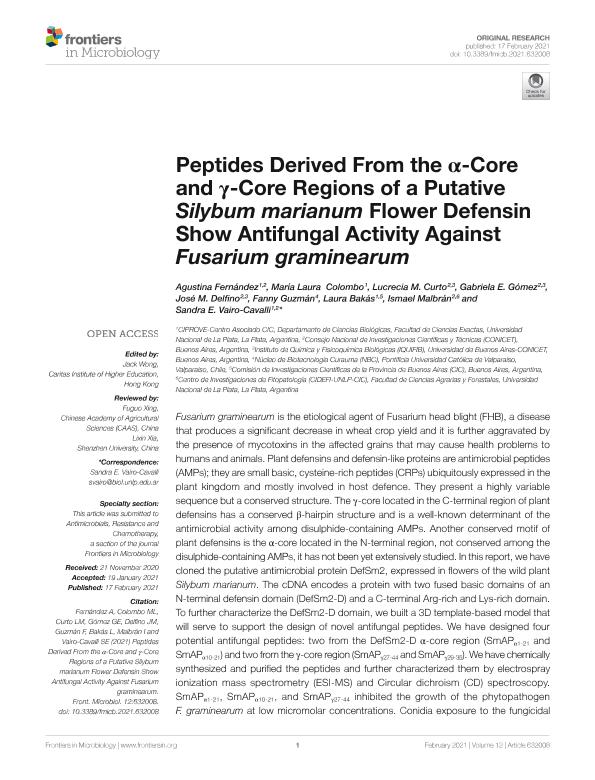Artículo
Peptides Derived From the α-Core and γ-Core Regions of a Putative Silybum marianum Flower Defensin Show Antifungal Activity Against Fusarium graminearum
Fernández, Agustina ; Colombo, Maria Laura
; Colombo, Maria Laura ; Curto, Lucrecia María
; Curto, Lucrecia María ; Gomez, Gabriela Elena
; Gomez, Gabriela Elena ; Delfino, Jose Maria
; Delfino, Jose Maria ; Guzmán, Fanny; Bakas, Laura Susana; Malbrán, Ismael
; Guzmán, Fanny; Bakas, Laura Susana; Malbrán, Ismael ; Vairo Cavalli, Sandra Elizabeth
; Vairo Cavalli, Sandra Elizabeth
 ; Colombo, Maria Laura
; Colombo, Maria Laura ; Curto, Lucrecia María
; Curto, Lucrecia María ; Gomez, Gabriela Elena
; Gomez, Gabriela Elena ; Delfino, Jose Maria
; Delfino, Jose Maria ; Guzmán, Fanny; Bakas, Laura Susana; Malbrán, Ismael
; Guzmán, Fanny; Bakas, Laura Susana; Malbrán, Ismael ; Vairo Cavalli, Sandra Elizabeth
; Vairo Cavalli, Sandra Elizabeth
Fecha de publicación:
17/02/2021
Editorial:
Frontiers Media
Revista:
Frontiers in Microbiology
e-ISSN:
1664-302X
Idioma:
Inglés
Tipo de recurso:
Artículo publicado
Clasificación temática:
Resumen
Fusarium graminearum is the etiological agent of Fusarium head blight (FHB), a disease that produces a significant decrease in wheat crop yield and it is further aggravated by the presence of mycotoxins in the affected grains that may cause health problems to humans and animals. Plant defensins and defensin-like proteins are antimicrobial peptides (AMPs); they are small basic, cysteine-rich peptides (CRPs) ubiquitously expressed in the plant kingdom and mostly involved in host defence. They present a highly variable sequence but a conserved structure. The γ-core located in the C-terminal region of plant defensins has a conserved β-hairpin structure and is a well-known determinant of the antimicrobial activity among disulphide-containing AMPs. Another conserved motif of plant defensins is the α-core located in the N-terminal region, not conserved among the disulphide-containing AMPs, it has not been yet extensively studied. In this report, we have cloned the putative antimicrobial protein DefSm2, expressed in flowers of the wild plant Silybum marianum . The cDNA encodes a protein with two fused basic domains of an N-terminal defensin domain (DefSm2-D) and a C-terminal Arg-rich and Lys-rich domain. To further characterize the DefSm2-D domain, we built a 3D template-based model that will serve to support the design of novel antifungal peptides. We have designed four potential antifungal peptides: two from the DefSm2-D α-core region (SmAP α1-21 and SmAP α10-21 ) and two from the γ-core region (SmAP γ27-44 and SmAP γ29-35 ). We have chemically synthesized and purified the peptides and further characterized them by electrospray ionization mass spectrometry (ESI-MS) and Circular dichroism (CD) spectroscopy. SmAP α1-21 , SmAP α10-21 , and SmAP γ27-44 inhibited the growth of the phytopathogen F. graminearum at low micromolar concentrations. Conidia exposure to the fungicidal concentration of the peptides caused membrane permeabilization to the fluorescent probe propidium iodide (PI), suggesting that this is one of the main contributing factors in fungal cell killing. Furthermore, conidia treated for 0.5h showed cytoplasmic disorganization as observed by transmission electron microscopy (TEM). Remarkably, the peptides derived from the α-core induced morphological changes on the conidia cell wall, which is a promising target since its distinctive biochemical and structural organization is absent in plant and mammalian cells.
Archivos asociados
Licencia
Identificadores
Colecciones
Articulos(CCT - LA PLATA)
Articulos de CTRO.CIENTIFICO TECNOL.CONICET - LA PLATA
Articulos de CTRO.CIENTIFICO TECNOL.CONICET - LA PLATA
Citación
Fernández, Agustina; Colombo, Maria Laura; Curto, Lucrecia María; Gomez, Gabriela Elena; Delfino, Jose Maria; et al.; Peptides Derived From the α-Core and γ-Core Regions of a Putative Silybum marianum Flower Defensin Show Antifungal Activity Against Fusarium graminearum; Frontiers Media; Frontiers in Microbiology; 12; 632008; 17-2-2021; 1-13
Compartir
Altmétricas



